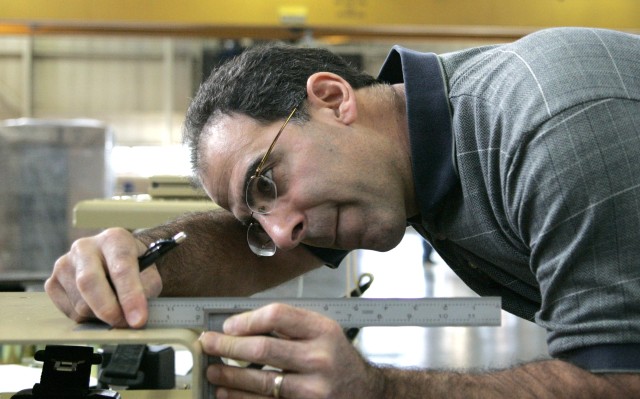ABERDEEN PROVING GROUND, Md. - Seventy-two hours to save Soldiers' lives. Seventy-two hours to assess, design, fabricate, integrate, test, adapt and produce a universal restraint system to ensure gunners won't be thrown from Mine Resistant Ambush Protected vehicles in the event of an accident or vehicle rollover.
Given that small window of opportunity one weekend, the U.S. Army Research, Development and Engineering Command pulled together its resources to deliver a Mine-Resistant Ambush Protected vehicle Gunner Restraint System to the warfighter in the field. This system increases safety and security for the Soldier in a battlefield environment.
RDECOM's Prototype Integration Facilities answered and delivered rapid results. These facilities specialize in prototyping rapid product developments to bridge the gap between the technology needs of the Soldier and the Soldier using those technologies in theatre. Working collaboratively, PIF staff from the U.S. Army Tank-Automotive Research, Development and Engineering Center and the U.S. Army Edgewood Chemical Biological Center teamed with the Army Developmental Testing Command's Aberdeen Testing Center to design, integrate, fabricate and test the new MRAP restraint system.
"It's like having a seatbelt in your car," said Sgt. 1st Class Amin Henriquez, noncommissioned officer of operations, RDECOM. "The restraint system prevents the gunner from being thrown from the vehicle in the event it gets hit. The system saves lives."
"A restraint system had already been developed for the Humvee, but not for the MRAP vehicles, according to Maj. Anh Ha, assistant deputy to the TARDEC Quick Reaction Cell.
The TARDEC Prototype Integration Facility therefore immediately began adapting an existing 5-point restraint harness and retractor used in Humvees for the various types of MRAP vehicles.
"There were several challenges to overcome," said Senior Engineer Mike Manceor. "No drawings or computer aided design models were available, and no two MRAP variants share the same bolt hole patterns."
Having no design drawings of the MRAPs, engineers measured and developed detailed drawings in order to make a prototype that would fit on each of the vehicles.
Designers had to climb into vehicles, physically measure the hole patterns and make detailed drawings from the measurements they took. The designs were then sent to the ECBC facility on Aberdeen Proving Ground where the staff fabricated the parts to build the system.
"ECBC PIF engineers collaborated with TARDEC engineers and program manager personnel in the onsite development and drawings of prototype hardware for GRS for the RG31/RG33 and Cougar vehicles," said Mark Schein, ECBC division chief, Advanced Design and Manufacturing.
Testing of the prototypes then took place at Aberdeen Test Center. Henriquez, who served as part of a team of Soldiers to help test the equipment through limited user evaluations, said he had confidence in the engineers who developed the technology. "It was like wearing another piece of Army equipment, I knew it was going to work."
The result--two universal kits, one designed to fit the RG-31 and three variants of the RG-33; and the other kit designed to fit the Cougar/JERRV.
By Sunday evening two basic designs, one for five of the vehicles and another for the remaining two, were complete. ECBC fabricated mounting hardware, engineers pooled drawing updates.
The collaboration directly supports the RDECOM mission of delivering rapid technology solutions, according to Gary Doggett, chief for Force Integration at RDECOM headquarters. The collaboration saved weeks and possibly months of coordination for completion.
The push had ended, but work continued. TARDEC provided designs and 50 Gunner's Kit platform plates to Blue Grass Army Depot supported Rock Island Arsenal, IL, with manufacturing. Designs, prototypes and bill of materials for all vehicles were completed, and kits were fabricated, assembled and shipped to theater.
"Our engineers work hard behind the scenes but often don't get to immediately see the fruits of their labor," said RDECOM Command Sgt. Maj. Hector G. Marin. "But with this project, they saw immediate impact. Their hard work and dedication saved lives within 96 hours of project completion."
I'm planning on future collaborations," said Jim Soltesz, TARDEC PIF director. "In my mind, I think of them [other RDECOM elements] as am arm, and extension of our organization." Soltesz said this partnership helped gain safety certification and fabrication efforts quicker, and in turn enabled the team to get the product to the Warfighter quicker.
Giving up a weekend for the PIF RDECOM team is not uncommon; they just want to complete the mission. "We're here to make things easier for the Warfighter," said Soltesz. "We provide protection and safety, that's our job...to make the Soldier's life easier so they can complete the mission." This isn't the first project they've done on deadline and the dedication does not falter with this team.
The MRAP gunner restraint system is slated to be completed by the end of February, according to Eric Emerton, spokesperson from the U.S. Army Tank-Automotovie Command.


Social Sharing